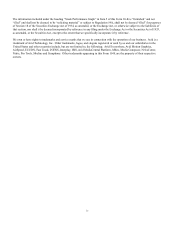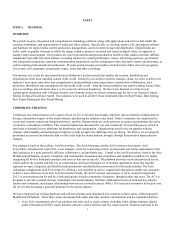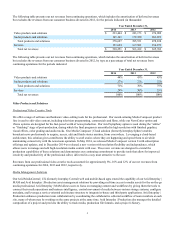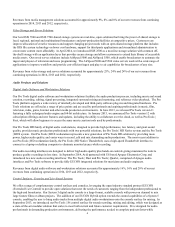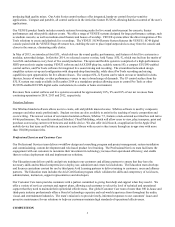Avid 2014 Annual Report Download - page 16
Download and view the complete annual report
Please find page 16 of the 2014 Avid annual report below. You can navigate through the pages in the report by either clicking on the pages listed below, or by using the keyword search tool below to find specific information within the annual report.10
our customers may also seek to pool or share facilities and resources with others in their industry and engage with providers of
software as a service.
We continually assess new products and solutions for our customers and we continue to implement our Avid Everywhere strategy
and platform designed to address changes in the industry by offering an open platform that will enable people to connect,
collaborate, store, manage, distribute, share and monetize media assets; however, the changes in the industry may reduce demand
for some of our existing products and services. Our competitive landscape continues to evolve as the media industry rapidly
evolves. New or non-traditional competitors may arise or adapt in response to this evolution of the media industry, which could
create downward price pressure on our products and solutions and reduce our market share and revenue opportunities.
Our success depends in significant part on our ability to provide innovative products and solutions in response to dynamic
and rapidly evolving market demand.
To succeed in our market, we must deliver innovative products and solutions. Innovation requires both that we accurately predict
future market trends and customer expectations and that we quickly adapt our development efforts in response. We also have the
challenge of protecting our product roadmap and new product initiatives from leaks to competitors that might reduce or eliminate
any innovative edge that we seek to gain. Predicting market trends is difficult, as our market is dynamic and rapidly evolving.
Additionally, given the complex, sophisticated nature of our solutions and our typically lengthy product development cycles, we
may not be able to rapidly change our product direction or strategic course. If we are unable to accurately predict market trends
or adapt to evolving market conditions, our ability to capture customer demand will suffer and our market reputation and financial
performance will be negatively affected. Even to the extent we make accurate predictions and possess the requisite flexibility to
adapt, we may be able to pursue only a handful of possible innovations as a result of limited resources. Our success, therefore,
further depends on our ability to identify and focus on the most promising innovations.
When we do introduce new products, our success depends on our ability to manage a number of risks associated with new
products including but not limited to timely and successful product launch, market acceptance, and the availability of products in
appropriate locations, quantities and costs to meet demand. For example, we have focused a significant part of our development
efforts on developing our Avid Everywhere Platform, discussed in the preceding risk factor. There can be no assurance that these
efforts will be successful in the near future, or at all, or that our competitors will not take significant market share in similar
efforts. If we fail to develop new products and to manage new product introductions and transitions properly, our financial
condition and operating results could be harmed.
Our international operations expose us to legal, regulatory and other risks that we may not face in the United States.
We derive more than half of our revenues from customers outside of the United States, and we rely on foreign contractors for the
supply and manufacture of many of our products. We also conduct significant research and development activities overseas,
including through third-party development vendors. For example, a significant part of our research and development is
outsourced to contractors operating in Kiev, Ukraine and Thailand and we are in the process of expanding our own development
activities to Taiwan and the Philippines. Our international operations are subject to a variety of risks that we may not face in the
United States, including:
• the financial and administrative burdens associated with compliance with a myriad of environmental, tax and
export laws, as well as other business regulations in foreign jurisdictions, including high compliance costs,
inconsistencies among jurisdictions, and a lack of administrative or judicial interpretative guidance;
• reduced or varied protection for intellectual property rights in some countries;
• regional economic downturns;
• economic, social and political instability abroad and international security concerns in general;
• fluctuations in foreign currency exchange rates;
• longer collection cycles for accounts receivable payment cycles and difficulties in enforcing contracts;
• difficulties in managing and staffing international implementations and operations, and executing our business
strategy internationally;
• potentially adverse tax consequences, including the complexities of foreign value added or other tax systems and
restrictions on the repatriation of earnings;
• increased financial accounting and reporting burdens and complexities;
• compliance with the applicable laws and regulations, including, for example, the EU Data Protection Directive, the
U.S. Foreign Corrupt Practices Act, or FCPA, and the U.K. Bribery Act, particularly in emerging market countries;


